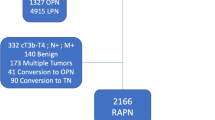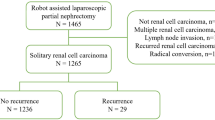Abstract
Partial nephrectomy is performed more frequently for small, incidentally discovered, low-stage renal tumors. Importantly, one should distinguish the imperative indications for such surgery from the relative and elective indications, while taking contraindications to nephron-sparing surgery into account. The main advantage of partial nephrectomy over radical nephrectomy is the avoidance of renal insufficiency; the major disadvantages include the possibility of local recurrence and perioperative complications. In this article, the literature on nephron-sparing surgery was reviewed in order to put the management of renal cancer into a modern perspective.
Key Points
-
Nephron-sparing surgery (NSS) for renal cell carcinoma has the advantage of reducing the risk of renal insufficiency by preserving kidney function; however, leaving the affected kidney in situ carries a risk of local recurrence
-
In patients with bilateral renal cell carcinoma, a solitary kidney, or impaired renal function in the contralateral kidney, every attempt should be made to preserve renal function
-
NSS is generally suitable for patients with single renal tumors of diameter 4 cm or less; candidates with larger or more complex tumors should be carefully selected
-
In order to avoid tumor recurrence it is important to ensure surgical margins are clear of disease; in patients with extensive tumor masses, or where lesions extend into the inferior vena cava or renal vein, partial nephrectomy is not recommended
-
Kidney damage due to warm ischemia is a problem when conducting NSS; renal hypothermia techniques can be used during surgery to limit its effect
-
Although still under development, laparoscopic partial nephrectomy techniques offer advantages to the patient compared with open surgery, reducing the need for postoperative pain medication and shortening hospital stay and recovery time
This is a preview of subscription content, access via your institution
Access options
Subscribe to this journal
Receive 12 print issues and online access
$209.00 per year
only $17.42 per issue
Buy this article
- Purchase on Springer Link
- Instant access to full article PDF
Prices may be subject to local taxes which are calculated during checkout
Similar content being viewed by others
References
Hock LM et al. (2002) Increasing incidence of all stages of kidney cancer in the last decades in the United States: an analysis of surveillance, epidemiology and end results program data. J Urol 167: 57–60
Pantuck AJ et al. (2001) The changing natural history of renal cell carcinoma. J Urol 166: 1611–1623
Robson CJ (1963) Radical nephrectomy for renal cell carcinoma. J Urol 89: 37–41
Lee CT et al. (2000) Surgical management of renal tumors 4 cm or less in a contemporary cohort. J Urol 163: 730–736
Novick AC (2002) Surgery of the kidney. In Campbell's Urology edn 8 (vol. IV) 3571 (ed. P Walsh) Philadelphia: Saunders
Nieder A et al. (2003) The role of partial nephrectomy for renal cell carcinoma in contemporary practice. Urol Clin North Am 30: 529–542
Novick AC and Derweesh I (2005) Open partial nephrectomy for renal tumors: current status. BJU Int 95: 35–40
Novick AC (2004) Laparoscopic and partial nephrectomy. Clin Cancer Res 10: 6322–6327
Herr WH (1999) Partial nephrectomy for unilateral renal carcinoma and a normal contralateral kidney: 10-year follow-up. J Urol 161: 33–35
Hafez KS et al. (1999) Nephron sparing surgery for localised renal cell carcinoma: impact of tumor size on patient survival, tumor recurrence and TNM staging. J Urol 162: 1930–1933
Patard JJ et al. (2004) Safety and efficacy of partial nephrectomy for all T1 tumors based on an international multicenter experience. J Urol 171: 2181–2185
Russo P et al. (2002) Partial nephrectomy: the rationale for expanding the indications. Ann Surg Onc 9: 680–687
Leibovich BC et al. (2004) Nephron sparing surgery for appropriately selected renal cell carcinoma between 4 and 7 cm results in outcome similar to radical nephrectomy. J Urol 171: 1066–1070
Hafez KS et al. (1998) Management of small solitary unilateral renal cell carcinoma: impact on central versus peripheral tumor location. J Urol 159: 1156–1160
De Sio M et al. (2003) Adrenalectomy: defining its role in the surgical treatment of renal cell carcinoma. Urol Int 71: 361–367
Joslyn SA et al. (2005) Impact of lymphadenectomy and nodal burden in renal cell carcinoma: retrospective analysis of the National Surveillance, Epidemiology, and End Results database. Urology 65: 675–680
Fergany AF et al. (2000) Long-term results of nephron sparing surgery for localized renal cell carcinoma: 10-year follow-up. J Urol 163: 442–445
Adkins KL et al. (2003) Partial nephrectomy safely preserves renal function in patients with a solitary kidney. J Urol 169: 79–81
Saranchuk JW et al. (2004) Partial nephrectomy for patients with a solitary kidney: the Memorial Sloan-Kettering experience. BJU Int 94: 1323–1328
Najarian JS et al. (1992) 20 years or more of follow-up of living kidney donors. Lancet 340: 807–810
Shirasaki Y et al. (2004) Long-term consequences of renal function following nephrectomy for renal cell cancer. J Urol 11: 704–708
McKiernan J et al. (2002) Natural history of chronic renal insufficiency after partial and radical nephrectomy. Urology 59: 816–820
Lau WK (2000) Matched comparison of radical nephrectomy vs nephron-sparing surgery in patients with unilateral renal cell carcinoma and a normal controlateral kidney. Mayo Clin Proc 75: 1236–1242
Gill IS et al. (2003) Comparative analysis of laparoscopic versus open partial nephrectomy for renal tumors in 200 patients. J Urol 170: 64–68
Lam JS et al. (2004) Changing concepts in the surgical management of renal cell carcinoma. Eur Urol 45: 692–705
Janzenn NK et al. (2003) Surveillance after radical or partial nephrectomy for localized renal cell carcinoma and management of recurrent disease. Urol Clin North Am 30: 843–852
Zincke H et al. (1998) Needle biopsy of solid renal masses [Abstract]. J Urol 159: 169
Lerner SE et al. (1996) Disease outcome in patients with low stage renal cell carcinoma treated with nephron sparing or radical surgery. J Urol 155: 1868–1873
Dechet CB et al. (1998) Nephron-preserving surgery for unilateral renal cell carcinoma: which pathologic variables contribute to contralateral renal tumor recurrence? [Abstract]. J Urol 159 (Suppl): 169
Bani-Hani AH et al. (2005) Associations with contralateral recurrence following nephrectomy for renal cell carcinoma using a cohort of 2,352 patients. J Urol 173: 391–394
Blute ML et al. (2003) Multiple ipsilateral renal tumors discovered at planned nephron sparing surgery: importance of tumor histology and risk of metachronous recurrence. J Urol 170: 760–763
Van Poppel H and Baert L (1994) Elective conservative surgery for renal cell carcinoma. AUA Update Ser 31: 246–251
Goethuys H et al. (1996) The case against fine-needle aspiration cytology for small solid kidney tumors. Eur Urol 29: 284–287
Li QL et al. (2003) Optimal margin in nephron-sparing surgery for renal call carcinoma 4 cm or less. Eur Urol 44: 448–451
Schlichter A et al. (2000) Where are the limits of elective nephron-sparing surgery in renal cell carcinoma? Eur Urol 37: 517–520
Kletscher BA et al. (1995) Prospective analysis of multifocality in renal cell carcinoma: influence of histological pattern, grade, number, size, volume and deoxyribonucleic acid ploidy. J Urol 153: 904–906
Hafez KS et al. (1997) Patterns of tumor recurrence and guidelines for followup after nephron sparing surgery for sporadic renal cell carcinoma. J Urol 157: 2067–2070
Uzzo RG and Novick AC (2001) Nephron sparing surgery for renal tumors: indications, techniques and outcomes. J Urol 166: 6–18
Lang H et al. (2004) Prognostic value of multifocality on progression and survival in localized renal cell carcinoma. Eur Urol 45: 749–753
Sutherland SE et al. (2002) Does the size of surgical margin in partial nephrectomy for renal cell carcinoma really matter? J Urol 167: 61–64
Van Poppel H (2004) The optimal margins in nephron sparing surgery. Curr Opin Urol 14: 227–228
Duvdevani M et al. (2005) Is frozen section analysis in nephron sparing surgery necessary? A clinicopathological study of 301 cases. J Urol 173: 385–387
Mickisch G et al. (2001) Guidelines on renal cell cancer. Eur Urol 40: 252–256
Van Poppel H et al. (1998) Partial nephrectomy for renal cell carinoma can achieve long-term tumor control. J Urol 160: 674–678
Albani JM and Novick AC (2003) Renal pseudoaneurysm after partial nephrectomy: three case reports and a literature review. Urology 62: 227–231
Van Poppel H et al. (2001) Incidental renal carcinoma and nephron sparing surgery. Curr Opin Urol 11: 281–286
Duque JL et al. (1998) Partial nephrectomy: alternative treatment for selected patients with renal cell carcinoma. Urology 52: 584–590
Stephenson AJ et al. (2004) Complications of radical and partial nephrectomy in a large contemporary cohort. J Urol 171: 130–134
Filipas D et al. (2000) Nephron-sparing surgery of renal cell carcinoma with a normal opposite kidney: long-term outcome in 180 patients. Urology 156: 387–392
Matin SF et al. (2002) Outcome of laparoscopic radical and open partial nephrectomy for the sporadic 4 cm or less renal tumor with a normal contralateral kidney. J Urol 186: 1356–1360
Kural AR et al. (2003) Outcome of nephron-sparing surgery: elective versus imperative indications. Urol Int 1: 190–196
Author information
Authors and Affiliations
Corresponding author
Ethics declarations
Competing interests
The authors declare no competing financial interests.
Rights and permissions
About this article
Cite this article
Joniau, S., Vander Eeckt, K. & Van Poppel, H. The indications for partial nephrectomy in the treatment of renal cell carcinoma. Nat Rev Urol 3, 198–205 (2006). https://doi.org/10.1038/ncpuro0458
Received:
Accepted:
Issue Date:
DOI: https://doi.org/10.1038/ncpuro0458
This article is cited by
-
Estimated functional renal parenchymal volume predicts the split renal function following renal surgery
World Journal of Urology (2015)
-
Follow-up study of unilateral renal function after nephrectomy assessed by glomerular filtration rate per functional renal volume
World Journal of Surgical Oncology (2014)
-
Induction of cold ischemia in patients with solitary kidney using retrograde intrarenal cooling: 2-year functional outcomes
International Urology and Nephrology (2013)



